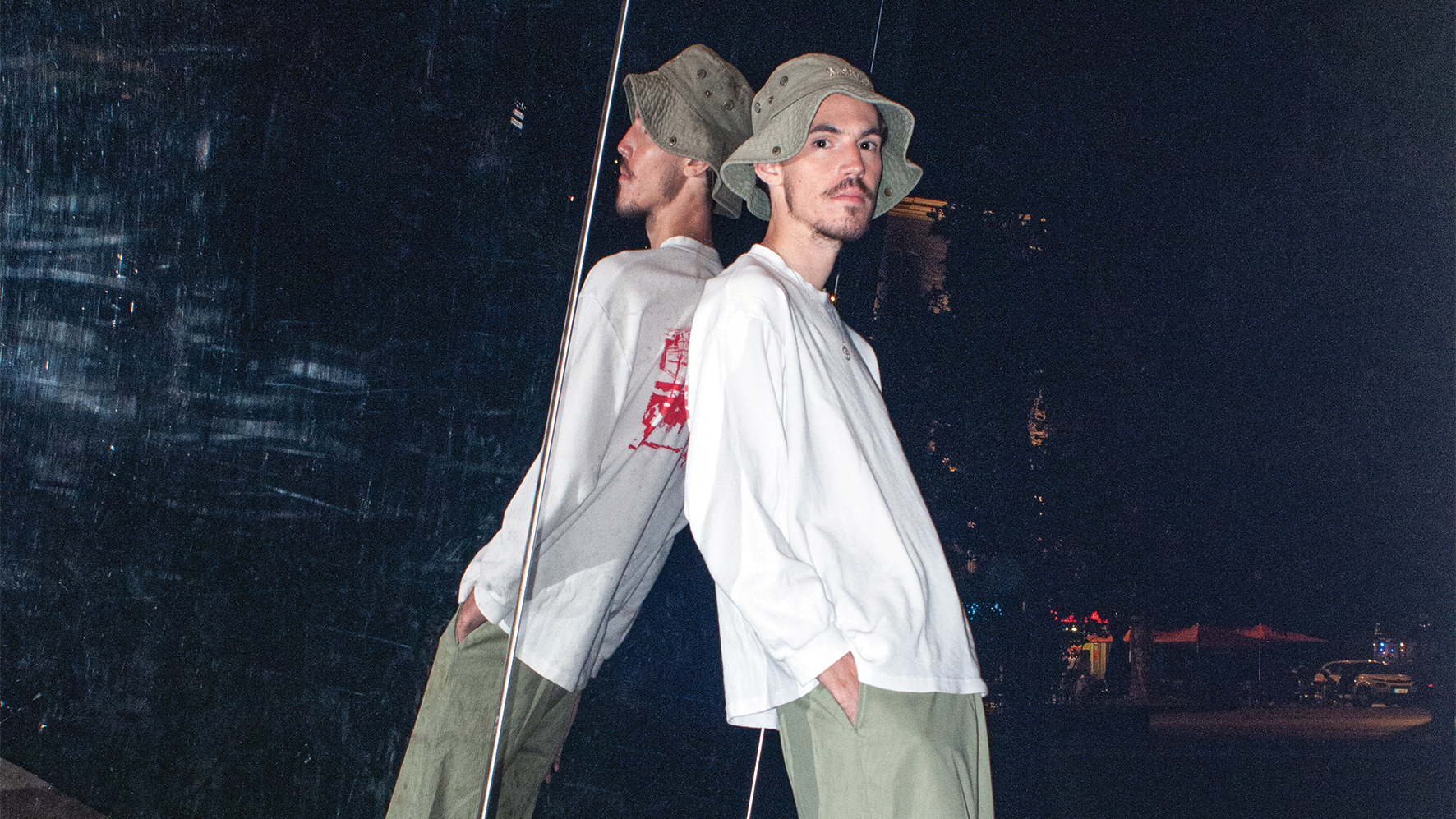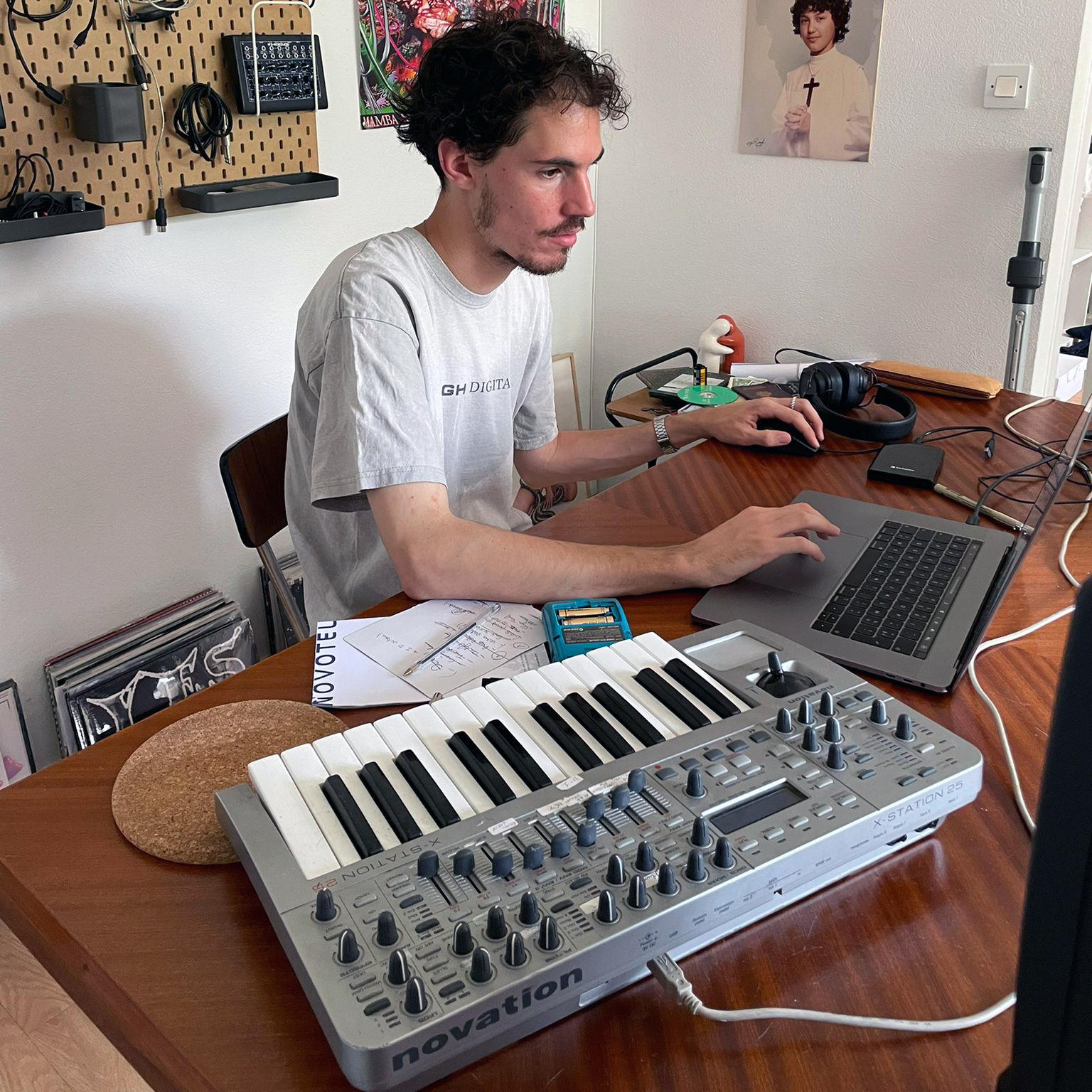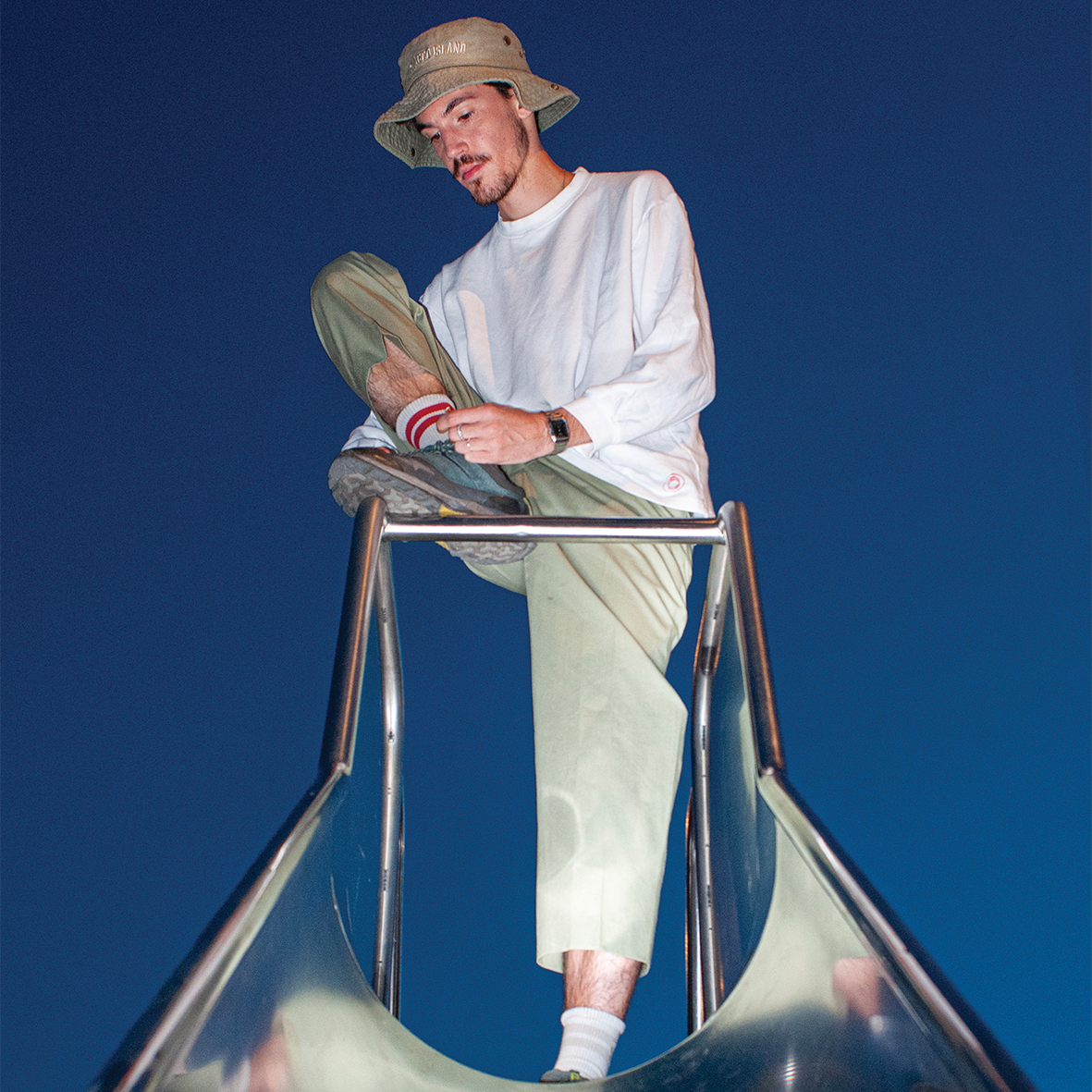Simo Cell: "I’m so used to Ableton that it’s become an extension of my mind - I’ll have an idea and in 10 seconds I can get it down without having to even think about it"
Having created 50 tracks in two years, Danny Turner chats to bass producer Simo Cell about the identity crisis that led to his mystical debut LP

After a tumultuous period of anxiety and self-doubt, French producer Simon Aussel found himself drawn to various spiritual philosophies that would only exacerbate his fragile state of mind.
Coming out the other side in 2020, the producer better known as Simo Cell embarked on a furiously productive creative period during which the self-confessed ‘sine wave sculptor’ produced 50 fully completed tracks departing from his affiliation to the Bristol bass scene.
Whilst sifting through and collating tunes for what would later become his debut Simo Cell LP, Aussel decided to build a mystical story arc relating to his period of personal crises. The resulting album Cuspide des Sirènes is an introspective, character-driven and scope-broadening adaptation that moves Aussel beyond his club identity into boldly creative yet unfamiliar territory.
As soon as you hear a Simo Cell track, it’s clear that you’re fascinated by sound. Where did that curiosity originate?
“I don’t have borders in my head and that probably comes from my dad being a classical guitarist. He’s a soloist from Argentina who chooses his own repertoire. During his concerts he might start with renaissance or baroque music, but will also play stuff that’s more contemporary and modern, which is weird in the world of classical music because you’re not supposed to do that.
“That curiosity probably answers why I wanted to play different types of music in my DJ sets, where it’s all about trying to build bridges between rhythm and melody even if other people can’t see it.”
Did you pick up a guitar before becoming interested in electronic music?
Get the MusicRadar Newsletter
Want all the hottest music and gear news, reviews, deals, features and more, direct to your inbox? Sign up here.
“Guitar was my first instrument. I went to music school from the ages of eight to 15 but left because it was too academic and cerebral and I hated it. When I stopped playing I had to take a break from music for a year or two, which is when I discovered electronic music through various internet forums.
“I found it to be such a different approach because there were so many different ways to achieve the same sound. I tried using Reason, then started using Ableton about 12 years ago and still use it now.”
Your latest album Cuspide des Sirènes has a strong narrative. Do you find it necessary to have a concept to write towards?
“Not really, because up to now I’d only been releasing EPs, but making my first album seemed like a much bigger step. When I was a kid I used to draw a lot and loved creating stories, but I didn’t think electronic music was a good place to do that because club music is more restrictive and that’s how I thought about myself as a musician.
“Over the past few years my approach has changed. I want to go beyond my club identity and make music without thinking about its destination. It’s been a big relief because I now feel more like an artist than someone who just makes club music.”
How did you approach the story arc behind the album?
“It’s weird but I didn’t have a concept in my head to begin with. So many club albums sound more like a compilation of tracks and when club artists feel like they want to be more serious they usually try to make some kind of empty ambient album. That approach was something I wanted to avoid, so the first thing I did was to just make lots of tracks spontaneously with no particular purpose.
“I had a fire in me – a kind of music bulimia where I couldn’t stop making music until I had 40 or 50 tracks. After two years I decided to stop that process of intense production, step back and select ones that would fit together. Building a narrative helped me to select those that would best fit.”
Were these tracks fully completed or rough ideas that needed to be further developed?
“They were all fully completed tracks, which is a bit crazy I suppose. I can only describe it as being like a blacksmith working with fire to build a beautiful sword, but the process also felt like a double-edged sword where I might get burnt or cut. It was a period of intense experimentation, but there’s still more doors to open with some of the tracks that were not selected for this album. It all feels like a starting point for something new.”
In English, Cuspide des Sirènes translates as ‘Mermaid’s Cusp’. How does that relate to some of the ideas behind this collection of tracks?
“The title is related to astrology. I was born on the cusp between Leo and Cancer and in mythology the transition between those two signs is called the Cusp of the Mermaid. I’m not really into astrology, but someone taught me about it and told me that I’m at the Cusp of the Siren, so that was a little nudge or way to create a literary reference for something I found to be interesting.
“The last few years have been pretty intense and anxious for me and making music has helped me to stay focused. Making the album became a kind of therapy.”
What roused such anxiety?
“A few years ago I turned towards personal development to deal with anxiety and came across Eckhart Tolle’s book The Power of Now that promotes an ideology around spirituality, dealing with the ego and creating a state of no mind to find permanent joy. It helped me initially, but I took it to a dangerous extreme where I was fighting against my ego, denying my emotions and neglecting the world around me.
“My girlfriend tried to warn me, but I didn’t listen and looking back I realise how easy it is to fall into such manipulative thinking. After realising it was all a dead end, I felt lost for a while. Then in 2020 I started making the album and found a path to gaining confidence and feeling more stable again.”

Is the album’s colourful and cartoonish cover art your handiwork?
“I spent quite a lot of time working with an artist on that. I had this idea of the Chimera [a fire breathing hybrid creature] and wanted to create some weird creatures around this aesthetic to accompany some of the tracks.
“In Greek mythology, they’re called ‘sirens’ and there’s also an octopus, which is quite important because every time I feel stressed I have this feeling that there’s an octopus in my head choking my brain. It’s all related to conveying my emotions.”
You’ve described your music as being proto-post-step, which implies it being a prototype of sorts. Do you see your music as being futuristic or innovative?
“I’m not a big fan of the ‘futuristic’ terminology. Music goes through cycles and innovation implies disruption. If you think about phones, for example, when smartphones dominated the market the old phones became obsolete, but that doesn’t work with music because when a new style comes along the old style still survives. There are trends of course, but things always come back.
“I’ve been DJing for 15 years and it’s so funny to see that pattern. I recently found an old hard drive and started digging into it. Five years ago, most of it wouldn’t have fitted my set, but it would be perfect to play right now. Innovation in music is also related to technology, but it’s way easier for everyone to make music now, which has changed how we perceive innovation.”
One part of your sound that is quite innovative is your vocal treatments. Are you sampling your own voice as well as other sources?
“On previous records I started to work with vocals more, so I wanted the voice to be one of the main elements of the album. There are so many new voice treatment plugins and techniques that interest me including various transient plugins that change vocal tonalities and Auto-Tune, which is still quite a big thing.
“I wanted the voice techniques to fit the siren mythologies that I mentioned and on some tracks I used samples. For example, on Behind the Waterfall the voice is a sample that I put in Ableton’s granulator. I also use software called Vocaloid, which is like a synthesiser where you can create voices from scratch.”
How does Vocaloid work exactly?
“It’s old AI technology that’s been around for about 10 years and most of the vocal tracks were made using it. It’s like working with a singer – you choose the vocal intonation and the lyrics and it gives you a lot of freedom to do your own thing. To me, vocals are more related to a sound than a message. When I listen to music I don’t pay much attention to lyrics, the texture or flow of the vocal is more important.
“Again, I really wanted to push this idea of sirens – in some cultures they are related to temptation, desire and risk, but in others they have more positive connotations. In Japanese folklore, sirens are associated with good luck and considered a symbol of protection and prosperity, so I wanted to rebuild that myth and use vocals to create feelings of charm and allure.”
There is a big debate surrounding how AI might be implemented in music. Do you believe that certain red lines need to be drawn?
“For me, music is always linked to an artist. It’s easy to make crazy beats with AI software that copy Jay-Z or Kanye and work really well, but I’d rather hear the personality of an artist than a copy of it.
“If AI-based music creates a new proposition then it could be exciting, but I don’t see it as a threat. We’re more likely to use AI to replace people in the world of licensing and it’s more of a threat for corporate jobs. Art is about an artist’s perception of reality.”
You mentioned being a long-time Ableton user. Do you see it as a sequencing tool or more of a creative engine?
“You can do everything in Ableton. I love how you can use it to tweak samples, but I try to do that in a very personal way. You can go very deep and completely change how the samples sound and the Drum Rack is really useful. I love that you can put effects on one element of a track and how it’s so fast and spontaneous. I’m so used to using Ableton that it’s become an extension of my mind. I’ll have an idea and within 10 seconds I can get it down without having to even think about it.”

Your music is very polyrhythmic. Are these complex drum patterns the scaffolding that you build everything else around?
“My comfort zone is to start with a drum pattern based on a track I’ve listened to or maybe a sample. With Ableton you can convert audio to MIDI, so I’ll grab a melody from a track as a MIDI file and just modify it. I also scalp a lot of sounds from Ableton’s MIDI kits and drum patterns. I'll find a snare or kick and spend two or three hours on it. I have so many projects open in Ableton and typically work on three or four tracks at the same time.”
Why do you prefer working on multiple tracks all at the same time?
“I find that the more time you invest in a track the more you want to finish it because you can’t let go of it, whereas if I’m working on two or three at the same time it’s not such a big deal because I’m just working on ideas and one track might merge with another.
“I’ll basically work for 45 minutes on a track, stop for 10 minutes and work on something else. That helps me to work faster and every time I reopen a project it sounds fresh because I forgot how it sounded. I even have a timer on my computer, so it’s quite a logical process and I’ll only do a maximum of four or five sessions per day, otherwise I tend to lose focus or spontaneity.”
What sound design plugins are you using?
“I use FabFilter EQs and the Saturn plugin for sound design as well as Thermal by Output because it’s like having my own nuclear basement. The presets are really good and a fun way to try out sounds, but if you want to be more precise it’s also very good for sculpting basses, drums and changing textures.
“Most of the kicks on the album were made with Native Instruments’ Massive X, which I love because it has an FM approach to sound design where you can use lots of oscillators and create really unique drum sounds. It’s really old-school, but I still like using FM8 because it’s so simple to use.”
Due to the relative complexity of the arrangements, will you mix as you go or leave that to the mixing stage?
“I try to separate the writing process from the mixing process, which means that once an arrangement is finished a track can sound really cheap because I still have an idea about how it will sound in the end. The only problem is that it takes a long time to then sculpt the sound.
“Although using reverb, delay and saturation is all part of sound design and can be really creative, I find that the mix down process is actually quite tedious [laughs]. This is the first album where I actually worked with someone on mixing, which was a big relief.”
Are you using any hardware outboard or is all your audio processing done in Ableton?
“I use a lot of UAD SSL and drum bus plugins for compression, but before I moved to Nantes I worked in a studio in Paris that had a lot of hardware tube EQs and compressors. We did blind tests comparing the software against the analogue hardware versions and it was impossible to tell the difference. Sometimes we even preferred the UAD software.”
We read somewhere that you are thinking about working with vocals in a more traditional sense at some point?
“You may not agree, but when I listen to Cuspide des Sirènes I feel that some of the techniques behind the production are definitely an invitation to work with pop artists. I wouldn’t be comfortable doing my own vocals, but I’ve started to produce a Latin vocal artist called Linapary and also Sassygirl from Buenos Aires. That’s something I want to crack because I feel that I’m going to have a lot to say over the next few years.”


“I’m looking forward to breaking it in on stage”: Mustard will be headlining at Coachella tonight with a very exclusive Native Instruments Maschine MK3, and there’s custom yellow Kontrol S49 MIDI keyboard, too
“Turns out they weigh more than I thought... #tornthisway”: Mark Ronson injures himself trying to move a stage monitor









